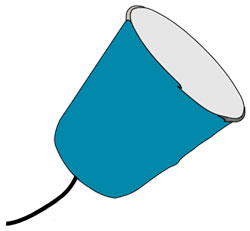Make a String Telephone What you'll need: - 2 paper cups
- A sharp pencil or sewing needle to help poke holes
- String (kite string and fishing lines work well)
Instructions: - Cut a long piece of string, you can experiment with different lengths but perhaps 20 metres (66 feet) is a good place to start.
- Poke a small hole in the bottom of each cup.
- Thread the string through each cup and tie knots at each end to stop it pulling through the cup (alternatively you can use a paper clip, washer or similar small object to hold the string in place).
- Move into position with you and a friend holding the cups at a distance that makes the string tight (making sure the string isn't touching anything else).
- One person talks into the cup while the other puts the cup to their ear and listens, can you hear each other?
What's happening? Speaking into the cup creates sound waves which are converted into vibrations at the bottom of the cup. The vibrations travel along the string and are converted back into sound waves at the other end so your friend can hear what you said. Sound travels through the air but it travels even better through solids such as your cup and string, allowing you to hear sounds that might be too far away when traveling through the air. More about phones: Landline telephones feature microphones that convert sound waves into electric currents that are then sent through wires and converted back into sound waves by an earphone inside the telephone at the other end. Modern mobile phones use radio waves (part of the electromagnetic spectrum that includes microwaves, infrared, visible light, X-rays and others) to communicate with base stations located throughout telephone networks. Phones have come a long way since Alexander Graham Bell was awarded the first electric telephone patent by the United States Patent and Trademark Office back in 1876. Today’s cell phones are a marvel of modern technology, featuring not only the ability to make phone calls but to also surf the web, play music, view documents and much more. | 
|